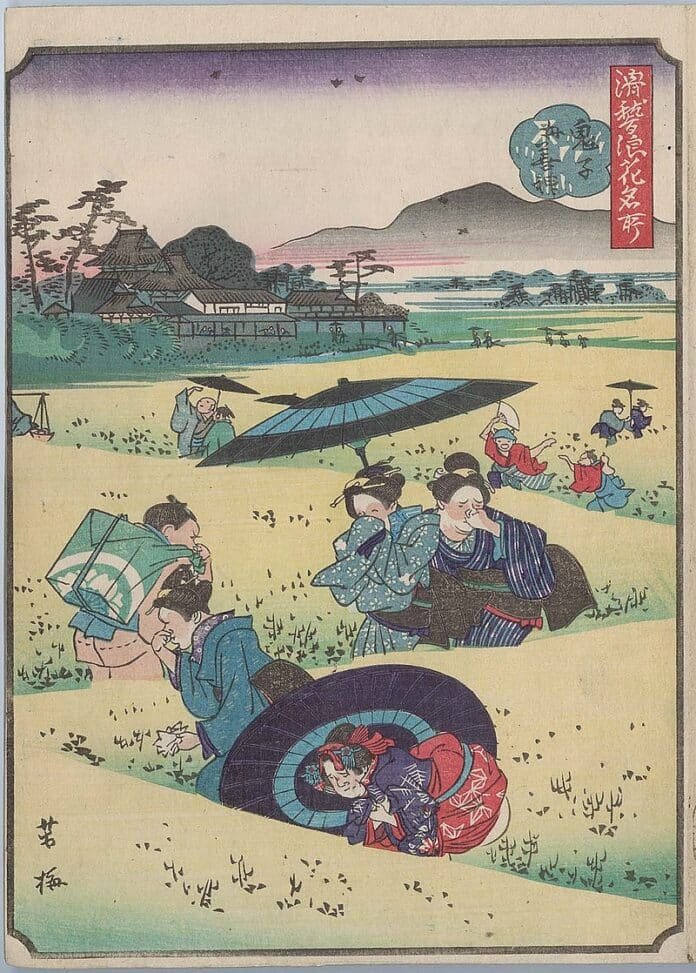
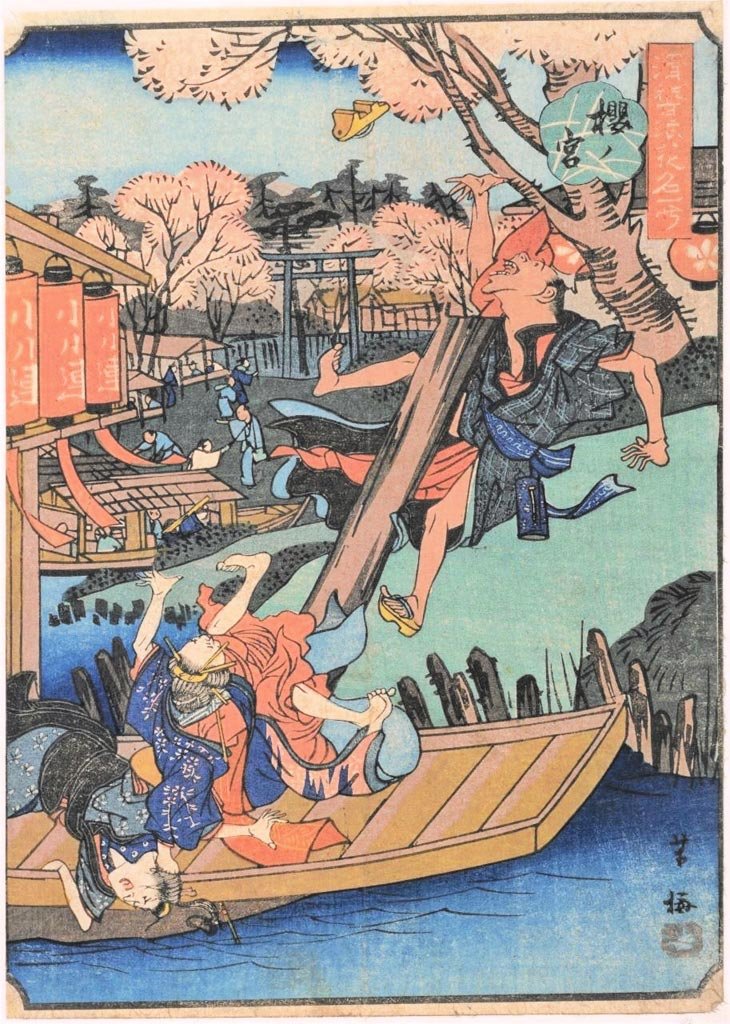
A while back in late May, I visited an exhibition at the Osaka Historical Museum. The exhibition was Naniwa hyakkei, hundred views of Osaka, consisting of historical woodblock style prints of the famous places and sites of Osaka, depicted in different times in history, mostly during the last 200 years to the beginning of 1900’s. As I am also a woodblock printmaker, it struck me as an interesting exhibition showing Osaka through ukiyo-e, traditional and well-respected local tradition of printmaking. It was very nice to walk around and see the old maps and prints of places I see every day, and how they were built around 100 years ago. It also became a sort of a game to try to spot out my dear neighborhood of Kujo from the maps, but mostly it didn’t appear to exist until fairly recently. Nevertheless, seeing the places and famous sights seemed to give some interesting context for this city that has felt more like home than probably any place I have lived before. Still, in that exhibition I also stumbled upon something unexpected, something that delighted me enormously, and that is the strange, wonderfully aho (”stupid”) world of Utagawa Yoshiume!
Utagawa Yoshiume, Nakajima by his own name, was born in 1819, in Osaka, and died here in 1879. He was the disciple of the world renown Utagawa Kuniyoshi, who is known for his surreal and imaginative imagery, sometimes scary ghost images, sometimes cats or sparrows going on with the everyday doings of human beings. It appears that some of his master’s imagination also seeped into the work of his disciple, who, among the many other sorts of works of course, made the series depicting ”Comical views of famous places in Osaka”, kokkei Naniwa meisho. He was one of the leading Osaka based ukiyo-e artists of his time and most of his work consists of portraits of kabuki actors, illustrations for books and other more common works, that are pretty much found through out every woodblock printmakers career, as they were what brought the bread to the table.
Usually ukiyo-e, the pictures of the floating world, paint the fleeting moments of human interactions, kabuki plays, nights out, themes taken from the nature and people admiring the beautiful natural view. Probably the first image to pop up to a Western mind is one of the most famous image of this type, the Great Wave from the series of 36 views from Mt. Fuji, by Katsuhiko Hokusai. They can work as a good introduction to ukiyo-e for newcomers, as they convey most of the key elements of the work; skillfully made, elegant, at best astonishing, beautiful and serious works of art. Of course these pictures come in all shapes, sizes and themes, let it be horror stories or gory displays of suicide, or townspeople fighting with farts, or some beautiful lady making love with an octopus, but the majority of the works one sees in the museums are usually of the sort that makes you gasp and admire the seriousness and dedication of the artist, carver and printer, all of whom come together to bring these beautiful works of art into the world. Most of the time one looks at the works in awe, trying to figure out how could somebody draw and cut lines so thin, when at least I appear to have the problem to get the nth cup of coffee from the table all the way to the mouth without spilling it all over. These intricate works of art somehow speak of the noble pride of the craftsmen and the artist, continuing their lineage and carrying onwards the name of their masters for the future generations to come.
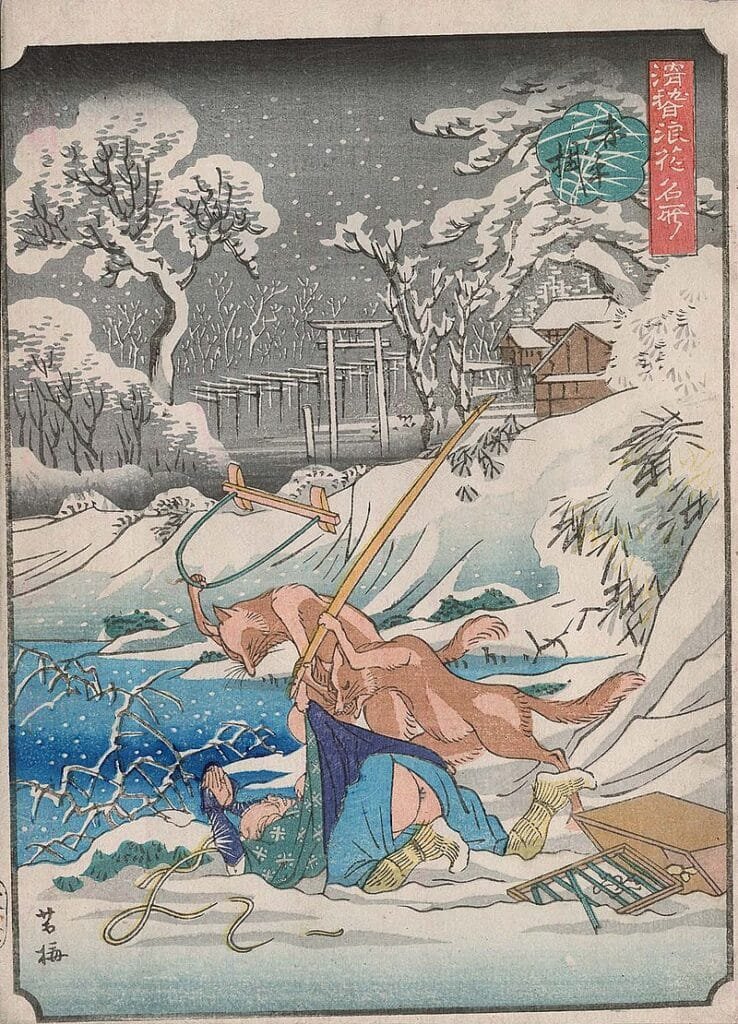
Having this sort of background of knowledge of the art presented, Yoshiume’s work seemed fresh and wild and they caught me by surprise. They are humorous and probably to some viewers vulgar, depicting for example a person of high stature on a beautiful horse, that just appears to be pissing like a waterfall all over the courtyard. In another image, an old lady is squatting in the rice field on a hot summer day, and the way the by-passers pinch their noses make you just almost able to smell the image. There is a depiction of bewildered foxes beating up an Inari shrine by-passer with sticks. There are also quite a few of pictures where drunk people are returning home at night, either dropping their precious sake and spilling it all over the ground, or being frightened by some ghosts that turn out to be either a kite stuck in the branches, or just the tree itself. But the expressions on the faces of these people, the insanely animate movement of the characters, all seems so humane and relatable that you somehow innately know how these people feel the kites and the branches are the ghosts from their childhood folktales. I think that is somehow a big part of it. As someone who grew up on the Finnish countryside, ghost stories and folk tales were a big part of teaching children what to do and what not to do. I mean, even as an adult I still might have some hesitations about looking under a lake pier in the unnatural fear of actually finding a Näkki, a Finnish water-yōkai lurking underneath it, so I can definitely understand how even grown up men can be scared to death of things and visions conjured by intoxication. Also there is something really revealing about depicting drunk people slouching back home. It tells you that it is normal, something you see quite often in real life, so I think there is a great deal of honesty in bringing that to art too. Art has sometimes a tendency to be a very carefully handpicked and selected view of reality, pretty and nice things instead of what it actually is, and for that reason it is sometimes refreshing to see something you see in your everyday life depicted in the art of the past too. It makes you have a sort of comforting feeling, that people have not changed too much, the past and the present are not too disconnected although many people build images based on these curated views on some era, and deduct that the life must have been utterly different back then. In the end, aren’t we all the same sort of beings with the same sort of fears and hopes and dreams? It is kind of hard to think that much of that would have changed in the last couple of thousand years at least, although our utilities and means of manifesting our hopes and fears in this reality have changed quite a bit even in my relatively short life time. But this is why depicting everyday things is important, it gives us a more well-rounded, honest view of an era and the wonderfully strange human beings that inhabit this Earth.
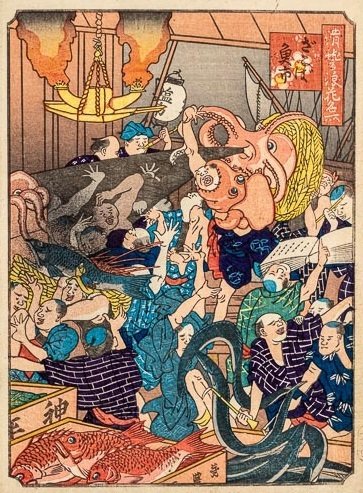
Among the works there were also visions of lively marketplaces, but of course there was always something absurd about them. A hawk stealing the just sold fish and everybody trying to desperately grasp it somehow, although the bird of course is flying further and further away with its delicious catch. Merchant reaching the top of the bridge with a big load of fruits, only to have them all toppled over and roll back down to the bottom. One of my favorites was the image where the fish marketplace was serving octopus so fresh, that they were in fact still choking the merchants and spraying ink all over the customers. It was interesting to think of the amount of work all of these prints needed in order to make them exist. All the sketching, carving the blocks, test printing the colors and doing it again and again until the image is perfect, only to produce an image of a pissing horse. I think there is some wonderful poetry in that. The ink jet of the octopus was done with a beautiful, technically flawless printing, which captured the eye for a long while as I was trying to figure out how much of it was printing and how was it carved. Especially because part of the ink is behind people, some of it is on top of them, which gives the image a totally new sort of 3 dimensional depth. Sometimes it would be interesting to see the blocks of some the works like this alongside with the print, but I understand that might be kind of a niche market. Although I think maybe if more people saw them, they might find more interest in diving into the traditional Japanese arts in the role of actual practitioner too, and that would secure the preservation of the arts in the long-term future too.
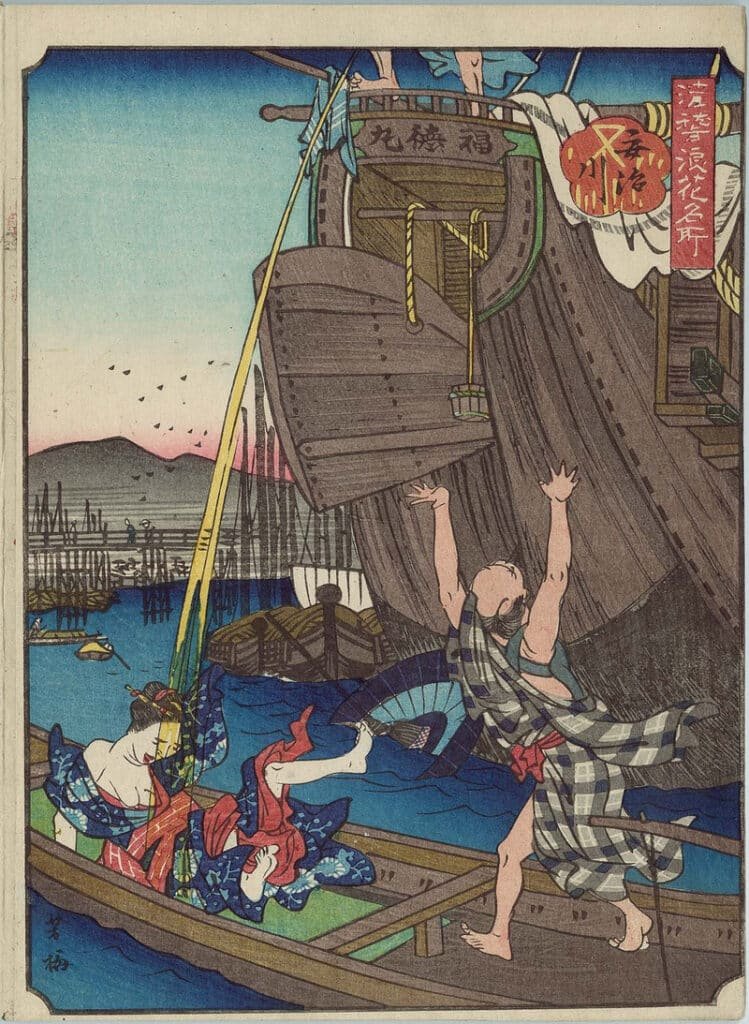
The color palette is also interesting, as the images are colorful and sometimes brightly so, actually so colorful that you might not at first even understand what you are looking at. It tricks you into believing the familiarity of visual context, your expectations for works of art deceives you. I am thinking now, that this might be somewhat an outcome of the modern visual culture we live in, as we are constantly blasted with all kinds of images and visual content. That, I think, is essentially the beauty of these prints. As your consciousness gets through the image and the sometimes strange composition of the it, little by little you start to build the image in your mind and you realize the oddity of it gradually. Your expectation guides your perception, and as your perception is deceived, the moment of realizing that you are being deceived seems like a small enlightenment of joy. It opens up like a flower inside your consciousness. I think quite a few modern artists would make all these works in earthly tones and try to depict the grimness and bleakness of the world of piss and squalor and filth and try to put some political message or twist to it, but that sort of blunt, boneheaded approach gets old quite fast. It is exactly this delicate balance and contrast of the color and subject matter, the absurd stupidness and the beautifully produced work of art that makes these prints so remarkable. It also makes one think that someone should probably produce something like this of our age for the future generations, just to let them know that we weren’t all just bleak doomers all the time, we also fell down clumsily and walked into a street light pole while looking at our phone, or something like that. Actually that reminded me of how in Osaka Hankyu trains there was a public service announcement commercial running on screens a few years back that showed noble samurai and other Edo period people trying to walk and look at their phones at the same time, falling into ditches and bumping into things. I thought that was genius piece of information sharing, but only managed to see it a couple of times.
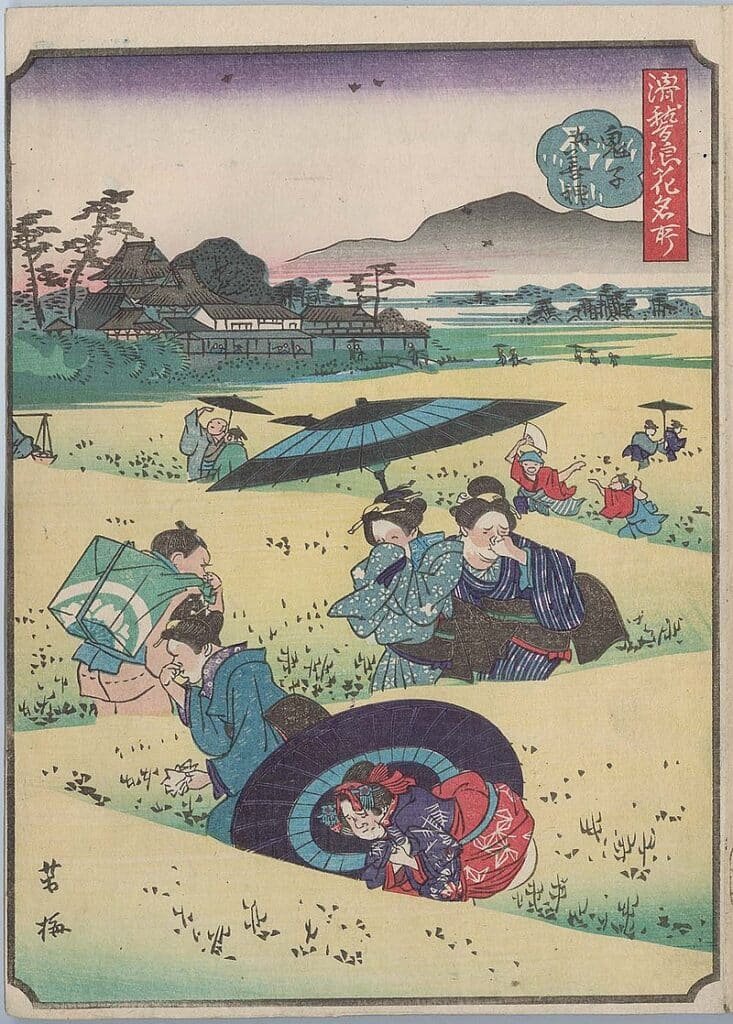
What was delightful about these prints was that they showed how the Osaka spirit has not changed in at least for the last two hundred years. As the city is largely known as a lively and welcoming business city of merchant origin, I think this somehow only half explains some of it. It is not only business or food that defines Osaka, there is something more real, more wild always hiding right beneath the surface. Real life in a way you don’t feel in a lot of larger cities. The fact is, Osaka doesn’t really feel as big as it is, and the different areas have a somewhat strong identities that make it feel strangely familiar to me at least. Basically, there is somehow a really countryside-like hands on approach to everything. A former teacher of mine used to laugh about the fact, that the rest of Japanese people are sightly scared of Osaka-folks, because whereas most Japanese do as they are told, Osakans do what they want, and it might be unexpected and strange. From my personal experience I would say that at least artists and musicians in Osaka are largely guided by hara, the gut feeling or intuition, and if that is how you happen to be build in this largely randomized lottery of genetics and environmental influence, you’ll probably fit right in. Of course a city this big has all kinds of people in it and I don’t know even a small percentage of them, but this has been how I have experienced it. For example when it comes to music, many of the Tokyo-based groups I have seen have a very well-rehearsed, tightly wound performances where you get the sense of professional approach, but also the lack of surprise, whereas Osaka and Kansai overall has probably more free spirited, open ended approach, where accidents and coincidences lead up to new discoveries and every performance becomes unique in that sense that it is happening right here and now, only this once, before it changes into something else for the next time.
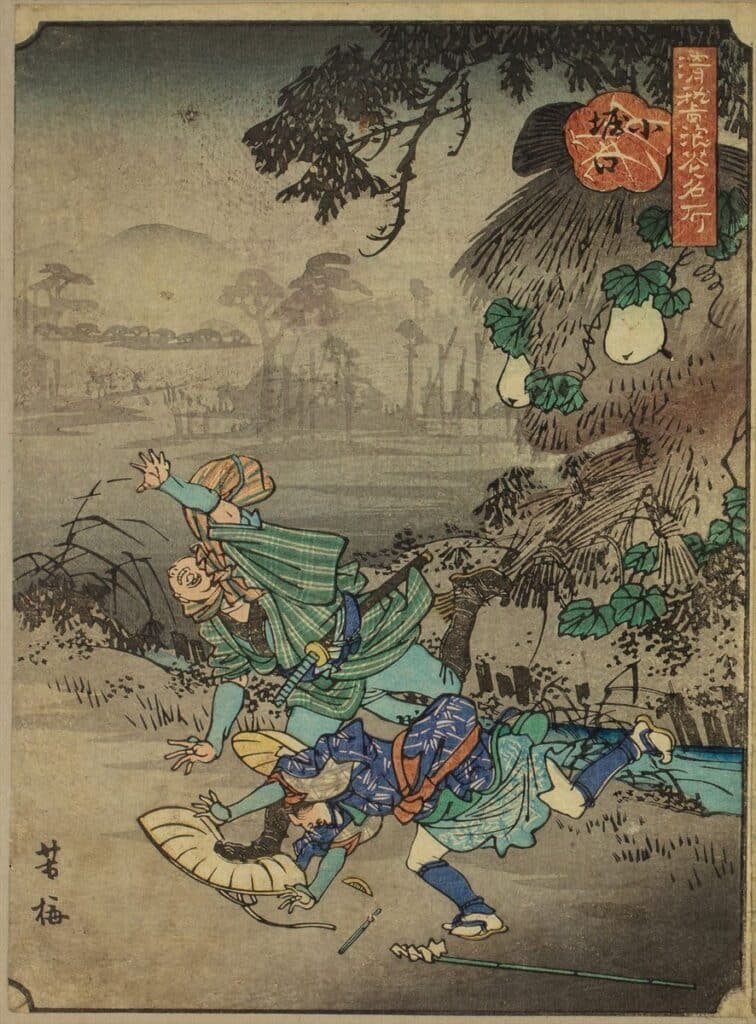
In Yoshiume’s prints one can sense the sort of absurdity that appears to be all around Osaka, written into the genetics of the city itself. It is exactly that random strangeness that keeps the city exciting and new each day even after years of living in here. The people, the places, hidden art galleries and cafes that most people won’t realize exist even when they are standing at the front door of it, Osaka is full of small, hidden secrets. The people can laugh at the strangeness of this life and then talk about the dreams they had with the sort of introspective insight that would make Jung feel like a high school student. In a way, because of the subtle balances like this, it feels like Osaka is always drifting somewhere between wake and dreams, although this may sound too esoteric or unnecessarily romantic expression to most readers. But the prints made me feel a strong connection to the city itself, the people, the way of living that is not probably only unique to Osaka itself, but to a certain wild and experimental spirit of cities that are ”not-capital”, but always slightly shadowed by it. It is a sort of liberating approach to existence itself, as the whole of the city is free from being the focal point for the rest of the world, and they can just pretty much do whatever they want. It allows more wild experiments, more free spirited searching of the new paths that other people don’t dare to tread on. That kind of spirit definitely allowed movements like Gutai art emerge in Osaka, which is something I will cover in the near future.
I hope that Yoshiume’s prints will be displayed in Osaka or anywhere else again in the near future in some larger extent, as I really think they truly capture the essence of Osaka in many ways words can ever tell.




















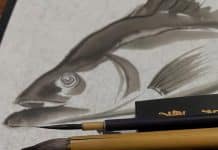





I saw the Utagawa exhibit earlier this year and remembered your great article.